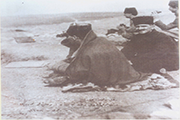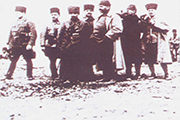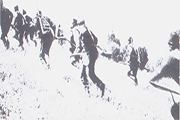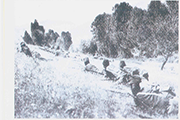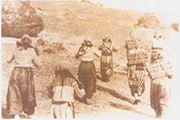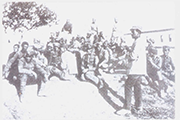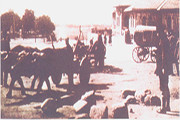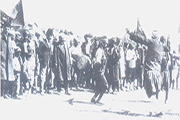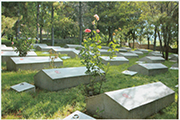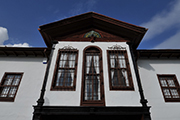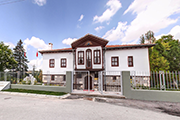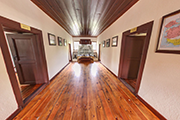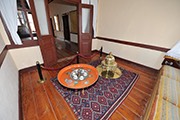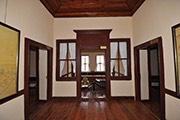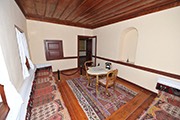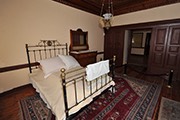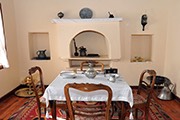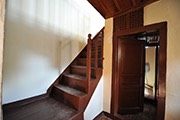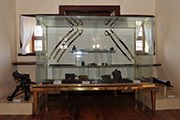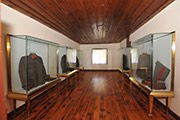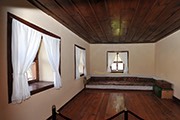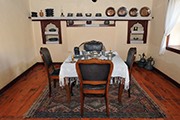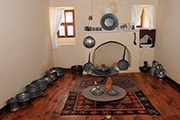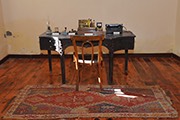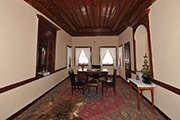Alagöz Headquarter
After the Battles of Kütahya-Eskişehir, the Turkish Army retreated to the line of Sakarya and then, in August 1921, both the headquarters of Commander-in-chief Mustafa Kemal and the headquarters of Western Front Command were located at a farmhouse in Alagöz. Alagöz Headquarters was mentioned in the Great Speech of Commander-in-chief Mustafa Kemal Atatürk as “On August 12, 1921, I and Fevzi Çakmak Pascha, Chief of General Staff, went to the front headquarters in Polatlı.” After the attacks of the enemy were repelled, on September 9, 1921, Commander-in-chief together with his idealist comrades and the necessary personnel moved to Karapınar Village which was 6 km away from Polatlı and located in the vicinity of Army Corps Headquarters in order to monitor the combats more closely. According to its current location, Alagöz Village is 4 km away from the road between Ankara and Polatlı. The turnout is 36 km away from Ankara and 31 km away from Polatlı. Alagöz Village is located approximately 9 km southeast of Malıköy train station. Today, there are 45 houses in the village and 285 people live there. It was then a little farm composing of several houses. Alagöz Village is proud to have hosted Commander-in-chief Headquarters of Turkish Armies during the Battle of Sakarya. A farmhouse belonging to Türkoğlu Ali Aga from the same village was used as the Headquarters building.
This farmhouse which was donated by Şerafettin Türkoğlu and Mahmut Türkoğlu the owners of Türkoğlu Farmhouse close to Alagöz Village served as headquarters to Turkish Armies and its great Commander-in-chief in the Battle of Sakarya. Commander-in-chief Mustafa Kemal received good and bad information about the Battle of Sakarya in this headquarters. Atatürk conducted most of the war which lasted uninterruptedly from August 23 till September 13, 1921 and prepared all his plans and made historic decisions in this farmhouse. After the Battle of Sakarya, the building continued to be used as a farmhouse by its owners Ali Türkoglu and his sons until 1965. In 1965, this farmhouse was donated to the Ministry of Education by its inheritors. In 1967, the building was again transferred to General Directorate of Ancient Arts and Museums subordinate to Anitkabir Museum Directorate and after being restored, it became a museum. This building was opened by the President Cevdet Sunay on November 10, 1968 with a ceremony. The ceremony which was held due to the opening of the museum on the 30th anniversary of the Great Leader Atatürk’s death has been accepted as the second exceptional case since Atatürk deployed the headquarters in Alagöz Village in 1921..
The building of Headquarters Museum was made over to Anıtkabir Command subordinate to General Secretary of General Staff on March 1, 1982. The building has two floors and contains 12 rooms. It is made up of stone and adobe. Exterior surface is covered with tiles. There are carved wooden decorations in the lounge at the upstairs and in some rooms. On the triangular frontal part located above the pillars in the front gate, there is a wooden peacock figure. The bottom and top floor plans of the building are square and in this place, there are rooms opening to middle lounge. Lounge and rooms are planned in a rectangular pattern. After restoration, only the top floor of the building was put on display in 1968 and the rooms in the bottom floor were left empty.
In 1983, some efforts were made to prepare the bottom floors for display and the necessary documents, books and photos were scanned and its appearance used in war time was tried to be regained. It was put on display after restoration on September 13, 1983.
First room in the right at the bottom floor was restored as Dressing Room. In this room, there are uniforms worn in the Turkish War of Independence. Second room in the right is Medical Room. In the Glass Case right across the entrance door, the pistol, rifle, sword and hand grenade taken from İstanbul Military Museum and Polatlı Artillery and Missile School Command are displayed. Two Steyr and Spanday brand machine guns are displayed in the both sides of the case. The room in the left corner was restored as Officers’ Messing Room.
The room in the left middle line was restored as kitchen like it used to be. The room in the left side of the entrance is Communications Room. There is various communications equipment in this room. Photos showing the Battle of Sakarya are displayed in the walls of the lounge at the bottom floor. First room in the right at the top floor is Commander-in-Chief’s Room. This room in which President of Grand National Assembly of Türkiye, Commander-in-Chief Mustafa Kemal made war plans together with his comrades under the light of an oil lamp was organized that we could commemorate him properly. Second room in the right was organized as Staff Officers’ Room. The room next to the Staff Officers’ Room is called Resting Room in which Commander-in-Chief Mustafa Kemal used to have his coffee when he felt fatigued due to the works. The room in the left corner is organized as Adjutants’ Room. The room in the left middle line is the Bedroom of Commander-in-Chief Mustafa Kemal. There are some personal belongings of Atatürk in this room. Bedspread, pillow, pillowcase, blanket, handglass and shoes case are among the personal belongings of Atatürk. The room next to Bedroom is Atatürk’s Dining Room. Little space above the penthouse was built for the orderly of Atatürk. Plans showing the Battle of Sakarya are displayed in the walls of the lounge at the top floor.
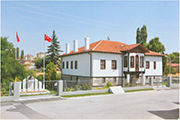
Facade
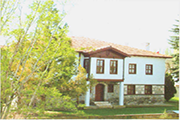
Facade
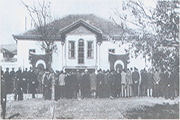
Opening Ceremony
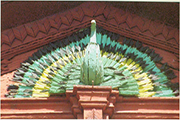
Peacock Figure
SAKARYA PITCHED BATTLE (14 AUGUST - 13 SEPTEMBER 1921)
Following the defeats in 1st and then the 2nd Inonu Battles, the Greek government decided to break and crush the Turkish army that is being established anew before ıt became more powerful. To do this, they increased the capacity of their military up to 125.000 persons and equipped it with new weapons and vehicles. After a 3-month preparation period, they started their attack on July 10, 1921.
After the Turkish army was defeated in Kütahya-Eskişehir Battles, the enemy besieged Afyon, Kütahya and Eskişehir cities. Then the Turkish army retreated towards the east of Sakarya River to be able to conduct a more effective defense strategy. Even though no troops were left behind after the defeat, half of the army was too weakened. All of the Turkish troops. Therefore, all the troops had to be reinforced, equipped and their needs be met as quickly as possible. However, there was not enough money and time and the only hope for success was Mustafa Kemal Pasha.
Then, the Grand National Assembly of Türkiye assigned Mustafa Kemal Pasha as the Commander in Chief. After this, the Commander in Chief Mustafa Kemal issued a 10-order declaration named the National Orders (Tekâlif-i Milliye) and demanded that the people have to give 40 % of their assets to the Turkish army. The former combatants or veterans were also ordered to join the army. Following this, the exhaustion and desperation among people declined before it expanded and a soul of bravery that would make the Legend of Sakarya emerged and the people gave almost all of their assets to the army.
The Greek army started to advance towards Sakarya on three directions on 14 August 1921 with the aim of leaving a division on the opposite side of the western front of Turkish army and then concentrating its all other troops on the South part of Sakarya River, breaching Turkish army and then besieging its left wing. Thus, they could destroy this national army. The Greek General Papoulas and its officers delegation believed that they could win this war. On 23 August 1921, on Tuesday morning, the Sakarya Battle began and the Greek Army started its assault with all its strength. They were extending their right wing on and on to besiege Turks on the left wing, however, they came across a self-sacrificing Turkish troop moving towards that wing all the time. The length of the frontline was over 100 meters. The new defense concept was: “There is no one line of defense but an area of defense, and that area is the whole country. Unless it is soaked with the blood of our citizens, it cannot be abandoned.” Therefore, no one could abandon even a tiny hill unless it was a crucial necessity.
Then, the Greek Army started to weaken quickly against this extraordinary and devoted defense and they could only advance ten kilometers on this front. They also started to have difficulty in their ammunition, food and petroleum since the Turkish cavalries infiltrated into the supply stores. Then, the optimistic mood in the Greek Headquarters started to turn into a deep concern and now was the time for the Turkish Army to start their attack. On 10 September 1921, on Saturday, Turkish troops started a counter attack. They first captured Duatepe on the right wing, and then the red flags were raised to the sky above the glittering bayonets. On the left wing, cavalries started to chase the fleeting enemy troops.
The Greek government issued an approval for their troops to retreat. However, the Greek Headquarters had already retreated to the West of Sakarya River. The General Papoulas was in panic and trying to rescue and retreat its troops before they are totally destroyed. This situation would be explained by the Greek Chief of General Staff, Dumanis, as “The Greek Army was too weak to fight, so they retreated.” after the battle. Then, the Greek Army lost half of its combat force and attacking power and retreated towards the West of Sakarya River.
Turkish victory was declared to its nation and the entire world on September 13, 1921. Toynbee, a famous historian, states: “It is one of the greatest wars in 20th century.” Claire Price, a journalist, states: “The West has been attempting to break up Ottoman Empire for 200 years. However, it confronted with the Turks in the Battle of Sakarya and the course of history changed once it touched the Turks. History will record this battle as one of the greatest events of our age.”
Grand National Assembly of Türkiye awarded Commander-in-chief Mustafa Kemal Pasha with the rank of “marshal” and the title of “veteran” after this great war and victory accepted as a milestone in Turkish history. Next step was to strike the last blow by pouring the enemy into the very depth of the sea. Thus, a comprehensive preparation needed until 26 August 1922.
At the end of the Battle of Sakarya, total casualty of the Turkish army was: 5.713 martyrs, 18.480 injured, 828 prisoners and 14.258 lost people, totally 39.279. Total casualty of the Greek army was: 3.758 dead, 18.955 injured, 354 lost people, totally 23.067.
We pay our great tributes to all our heroes who contributed to this great legend.
FUNCTIONING OF COMMANDER -IN-CHIEF HEADQUARTERS ESTABLISHED IN ALAGÖZ VILLAGE AT THE SAKARYA PITCHED BATTLE
The Commander-in Chief Headquarters, established in Alagöz village, was the focal point of our domestic front line. The closest place from Alagöz village to the front line was 40-45 km on Karailyas train station to the west. Due to its position, it was the safest place to surge soldiers and execute the Commander-in Chief and Western front line headquarters..
The Commander-in Chief and Western front headquarters were build next to each other in Alagöz village. As soon as they got intelligence about the battle, İsmet Pasha and Atatürk would analyse it in the Commander-in Chief Headquarters and they would decide what to do about the battle the next day.. These decisions would be written as orders lengthy in order to be sent to the units in front line headquarters. Then, these would be confirmed by Mustafa Kemal Pasha in the house used as Commander-in Chief. Western Front Line Headquarters was place where the intelligence were attained and published. The Commander-In Chief Headquarter was the place where the intelligence was reviewed and decisions were taken.
Halide Edip also visited Alagöz.
As we infer from her work “Ateşten Gömlek”; light of Atturk’s office was on till dawn. He used to keep working without sleeping. He carried out his works at Alagöz HQ with one of his ribs broken during 22 –day –and-night Sakarya Pitched Battle.
On August 5 1921, the resolution which gave Mustafa Kemal Pasha the authority to become Commander-in Chief was adopted; he established the Commander -in Chief Headquarter thanks to Presidency of General Staff and Ministry of National Defense Headquarters and in order for them to function consistently, a private secretary connected to the Commander-in Chief was formed. Commander-in Chief Private Secretary was formed by;
A Chief
An Aide-de-camp
2 Staff Officers
A Clerk
The Commander-in Chief was Mustafa Kemal Pasha in the new organization.
The Chief of General Staff was Fevzi Pasha and The Western Front Line Commander was İsmet Pasha. With the establishment of Commader-in Chief Headquarter at Sakarya Pitched Battle in Alagöz and the Commander-in Chief, General Staff and Western Front Line Headquarters working together increased the efficiency of the operations administration.
The reminiscence of General Asım Gündüz which was published years later clearly indicates how Turkish soldiers overcame their enemies in the war of independence. Here is a quotation of his memories: "With the order of Mustafa Kemal I started my duty in Western Front Line Turkish General Staff. Our headquarter was located in Alagöz village. It consisted of two farm house without any windows. Mustafa Kemal Pasha stayed in one of them, İsmet Pasha and I as a Staff Officer stayed in the other. There were 4 people in the Headquarter including Tevfik Bıyıklıoğlu. The others were staying in tents. The first thing to do was to organize food supply. How were we going to feed our army? This was the main issue. It was summer. We ordered them to cook the crops, to grind them till it become flowers, to bake bread using bakery, to cook supplied cattle. We took these precautions for the last Turkish Republic ever. Otherwise the last Turkish Republic was being demolished. The clothing of our soldiers was heartbreaking."
UNITS AND COMMANDERS FOUGHT IN SAKARYA PITCHED BATTLE
|
Commander -in Chief |
Mustafa Kemal |
||
|
Chief of General Staff |
Fevzi (akmak) Pasha |
||
|
Western Front Line C. |
İsmet (İnönü) Pasha |
||
|
Western F.L. Chief of Staff |
Col. Asım (Gündüz) |
||
|
1st. Group C. |
Col. İzettin (Çalışlar) |
||
|
23th Division C. |
Lt.Col. Ömer Halis (Bıyıktay) |
||
|
24th Division C. |
Lt.Col. Fuat (Bulca) |
||
|
II. Group C. |
Col.Selahattin Adil |
||
|
4th Division |
Col. Mehmet Sabri (Erçetin) |
||
|
5th Division |
Lt.Col. Kenan (Dalbaşar) |
||
|
9th Division |
Col. Sıtkı (Üke) |
||
|
III. Group C. |
Yusuf İzzet Pasha (Major General) |
||
|
7th Division C. |
Lt.Col.Derviş |
||
|
8th Division C. |
Col. Kazım |
||
|
15th Division C. |
Col.Şükrü Naili (Gökberk) |
||
|
IV. Group C. |
Col.Kemalettin Sami |
||
|
5th Caucasian Div. C. |
Lt.Col. Cemil Cahit (Toydemir) |
||
|
61th Division C. |
Lt.Col. Rüştü (Sakarya) |
||
|
V. Group C. (Cavalry) |
Col. Fahrettin (Altay) |
||
|
14th. Cav. Div. |
Lt. Col. Suphi (Kula) |
||
|
4th. Cav. Brid. |
Col. Hacı Arif |
||
|
XII. Group C. |
Col. Halit |
||
|
11th Division C. |
Col. Ali Hikmet (Ayerdem) |
||
|
Reorganized Corps C. |
Col. Kazım (Özalp) |
||
|
1st. Division C. |
Lt. Col. Abdurrahman Nafiz (Gürman) |
||
|
17th Division C. |
Col. Hüseyin Nurettin |
||
|
41th Division C. |
Col. Şerif (Yaçağaz) |
||
|
1st Cav. Div. C. |
Lt.Col. Osman Zati (Korol) |
||
|
Westernline C. |
|||
|
6th Division C. |
Lt.Col. Nazmi (Solak) |
||
|
57th Division C. |
Lt.Col. Mümtaz |
||
|
C. |
Lt.Col. Halit (Akmansu) |
||
|
Reorganized Div. C. |
Lt.Col. Ahmet Zeki (Soydemir) |
||
|
2nd Cav.Div. C. |
Lt.Col. Ethem Servet (Boral) |
||
|
3rd Cav. Brid. C. |
Col. İbrahim (Çolak) |
||
|
To Commander in Chief, Sakarya Pitched Battle lasting from 23 August was concluded with certain victory of Turkish Grant National Assembly Army. As of this afternoon, the armies of our enemy was defeated and completely thrown into western side of Sakarya River with the effect of general counter attack lasting for three days. We are continuously watching the enemy. 13.9.1921Commander of Western Front, İsmet |
|||
Ghazi Marshall Mustafa Kemal published a statement to the army on 20 September 1921.
Friends! You have won a great victory against enemies in order not to see our nation as slaves in Sakarya Pitched Battle and this will never be forgotten. As someone who has spent many years of his life as comrade in arms, I'm glad to express how much i admire the soldiers who didnt even hesitate to sacrifice their live for their country.The battle we fought in Sakarya was putting at risk a corner or a large part of the motherland at risk as in many previous battles. The whole country engaged in a great battle there at the expense of our entire existence and independence. For 21 days and 21 nights the idea of independence of one nation and the idea of war and looting of another nation fought one another. Your ideas of independence left the enemies no choice but to turn back. The enemies are returning to where they came from as murderers running from punishment, leaving behind hundreds of our villages burning over an angry horizon. They were only planning a raid, not a battle. There cannot be a bigger proof than the victory you achieved for the strength of thinking and belief. I am deeply happy and proud to have been your commander in chief in this battle which restored the light and independence for our suffering nation in the most dangerous period of its history.
“To the Commanders”
For the valor you demonstrated in the successful deployment and managing of the battle with your determination, attention and ever-increasing intelligence:
“To the Military Officers”
For your countless heroic acts that I witnessed batlle after battle right after Tripoli, Balkan and the World Wars,
"To the Soldiers"
I knew all of you in battlefields long before we began our war for independence. In no other armies in the world, there have been such clean hearted and brave soldiers. The base of every victory lies within morality. The biggest part of victory is morality. I would like to express my graditute to the soldiers who overcame the enemies, in my opinion, with faith, blief and a clean heart strong as a steel.
Seeing commanders, officers and soldiers as slaves in such a country is not an option. The rank and war veteran title given to me by the Grand National Assembly of Türkiye is yours. Army is the one rises with the title given by this nation: once again army is the one outstanding with the honored and Great War. I will hold this title with honor as an indicator of my military life, regarding the sacrifices you have made for this country. I wish God Almighty to bestow my noble comrades, nobility, bravery and chivalry which symbolize the absolute independence.
20 September 1921
Commander-in Chief Mustafa Kemal
“Turkish Child”
Always feel gratitutes towards us. We lie before the God wrapped in martyrdom shirt and covered with caftan sewed by the angels. We observe the angel sayings “God is august, one who loves his/her country is, too, august and those who sacrifice their life for the nation are more august before the God”. We beg of the God who open out the doors of acceptance and glory to us.
You the Turkish Child,
Love the Turkih Nation, assist Turkish Nation in its efforts to improve and make your nation prosperious.
Keep high the independence flag and your dignity! May God’s mercy be upon us!”
|
LOSSES IN SAKARYA PITCHED BATTLE |
||
|
Martyr / Dead |
Wounded |
|
|
Turkish |
5.713 |
18.480 |
|
Greek |
3.758 |
18.955 |
